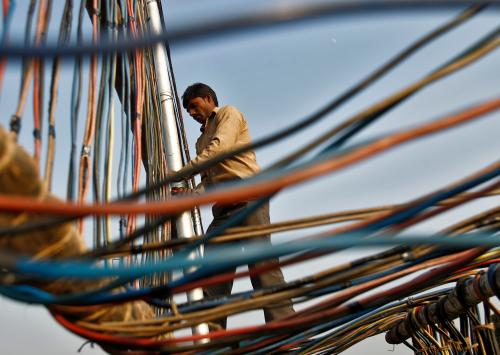October 11 marked a major advancement for the implementation of smart grids when Reactive Technologies (RT) successfully transmitted data packets over the United Kingdom’s national grid through preexisting electrical cables. Smart grid technologies such as the internet of things (IoT) can augment existing power grids using a wealth of data from consumers and producers. Machine to machine communication is expected to generate billions of dollars in both productivity gains and cost savings from reduced energy consumption. However, the deployment of 5G networks capable of supporting a widespread IoT ecosystem is still a number of years off. In that regard, electrical data packet transmission provides an analog alternative for optimizing aggregate power consumption with reduced cybersecurity risk.
An electricity grid integrated with big data would complement renewable energy goals that rely on variable generation technologies like wind and solar. A smart grid could display a dashboard view of the entire system, with information constantly being communicated by power generators, transmission lines, transformers, and consumers across the network in real time. Such a dynamic exchange would enable power providers to more accurately generate and distribute electricity in line with consumer demands, increasing efficiency by both modulating appliance consumption and leveling expensive peak load generation. Moreover, it would reduce information asymmetries within wholesale energy markets, allowing regional grids to buy and sell energy when it is economical to do so, and facilitate network troubleshooting in the case of outages. Countries face significant obstacles realizing such a vision, however, due to the energy sector’s reliance on legacy technologies and the need for interoperability on a national scale.
Reactive Technologies’s recent proof of concept is remarkable for demonstrating how a type of smart grid could be built without major capital investment. By inserting high-frequency data packets into standard 50Hz electrical signals, RT communicated with 20 truck-sized resistors scattered across the UK’s national grid without degrading either the messages or electricity in the process. In practice, this would enable power utilities to calibrate appliance power consumption during both peak and off-peak times, assuming they come equipped with smart plugs capable of interpreting the incoming data packets. Ideally, the adoption of such large-scale optimization would result in the creation of “virtual power stations” to manage entire swathes of residential and commercial customers as unique entities.
Although such an analog system might not possess the same functionality of a digital smart grid, it addresses certain issues associated with the latter. Not only do digitized grids create cybersecurity vulnerability within national energy supplies, they also obstruct “bounce back” efforts in the wake of outages due to fragmented software and network technologies employed by utilities. The availability of analog infrastructure would create redundant systems for use during outages. Furthermore, because the data transmission technique integrates seamlessly into existing infrastructure, the retrofitting costs associated with such a plan would be distributed among appliance manufacturers upgrading to “smart plugs” instead of large-scale, tax-funded government tenders. Consumers would also prefer the anonymity of such a one-way regime to the perpetual vigilance of their energy consumption by digital power grid systems.
While the developed world has committed to a transition to intermittent renewable energies, 20th century grids will fail to mitigate volatility in power supply. Digitization would undoubtedly improve communication between the plants, transmission lines, and substations whose current lack of awareness results in longer blackouts, redundant peak generation, and reduced diversity of energy sources. However, current-based data delivery that aggregates consumption, rather than analyzing each customer’s individual needs, would limit cybersecurity risk along the last mile between substations and customers. Ultimately, the future of power distribution will probably come to reflect a combination of both low-tech and high-tech grid improvements.
Maximilian Fiege contributed to this post.










Commentary
An analog method for building smart electrical grids
November 1, 2016